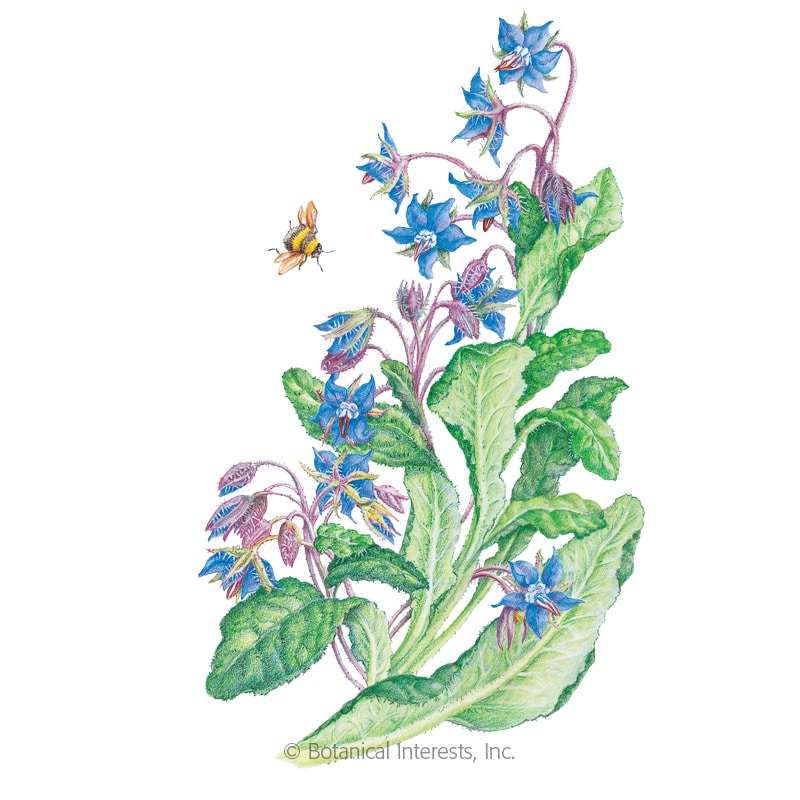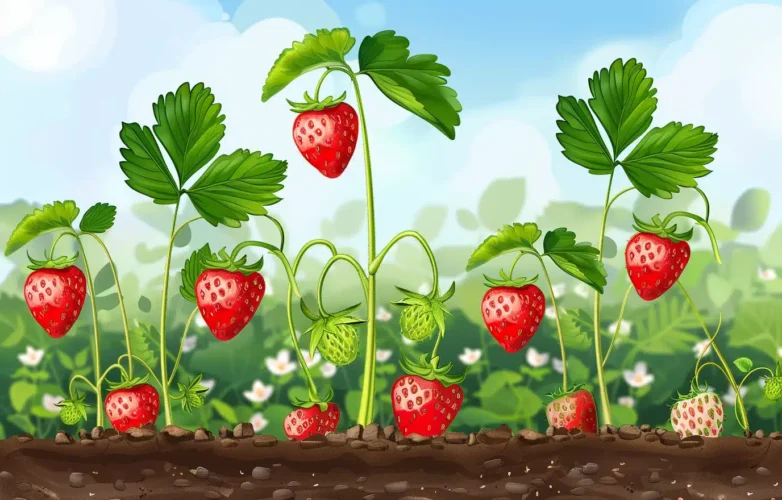
Strawberries are sweet, delicate little fruit that are vulnerable to many pests and diseases. Because of this, many gardeners turn to companion plants to help provide some protection for their budding berry patches. Companion planting is the art of growing one or more plants next to each other to create a symbiotic relationship. The best companion plants offer a combination of benefits such as repelling pests, improving flavor, attracting beneficial predators, adding nutrients to the soil, and protecting soil moisture. In this article, we'll break down the best and worst companion plants for strawberries.
Snapshot: Best & Worst Strawberry Companion Plants
Best Companions:
Best strawberry companion plants are borage, dill, bush beans, lavender, alyssum, yarrow, onions, garlic, and fennel.
Worst Companions:
Worst companions include cabbage, potatoes, tomatoes, peppers, and roses.
Neutral Companions:
Friendly companions that grow well with strawberries include marigolds and perennials such as rhubarb, asparagus, and horseradish.
How to Choose Strawberry Companion Plants?
Only you can decide which companion plants will ultimately be best suited for your strawberry patch. Each plant described in this article provides a certain benefit when planted alongside strawberries. The key is to figure out what kind of support your strawberry patch needs and decide if that need can be solved with companion planting. For example, if you are struggling to keep your strawberry patch fertilized, it may make sense to plant a few nitrogen-fixing companion plants to help draw nutrients into the soil. If aphids are your problem, try planting companions which deter pests and/or attract beneficial predators that eat aphids. If space is limited, then try combining a variety of perennial companions into one, easy-to-manage garden bed. Here are a few benefits that companion planting can offer:
Repel Pests:
Some plants have the ability to repel certain plant pests. The best companion plants for strawberries are those which repel common berry pests like aphids, whiteflies, birds, etc.
Attract Predators:
Instead of repelling pests, some plants attract predators that feast on common pests and keep their populations low. Examples of beneficial predators include include hoverflies, lacewings, ladybugs, and parasitic wasps.
Fertilize the Soil:
Nitrogen-fixing plants are plants with roots colonized by a bacteria called rhizobium. This bacteria will draw nitrogen from the air into the soil and improve it.
Provide Shade & Moisture:
Cover crops, ground cover, and tall leafy plants are examples of plants that provide shade and moisture retention. Ground cover plants shield the soil and prevent moisture loss while tall leafy plants provide shade.
Improve Flavor Profile:
Did you know that the oils and aromas of certain plants can actually impact the flavor of nearby plants? For example, borage flower has been known to positively change the taste of strawberries planted nearby.
5 Best Strawberry Companion Plants
Borage:
Borage flower is like the Swiss-Army knife of companions for strawberries! Borage attracts beneficial predators, such as certain wasps, which seek and destroy potential strawberry pests. The flower also adds nutrients to the soil and is said to improve the flavor of strawberries (in our opinion, borage gives strawberries a slightly floral undertone). Like strawberries, borage blooms in early summer and continues blooming until the first frost.
Shop for Organic Borage SeedsOnions & Garlic:
Onions belong to the allium family (like garlic, leeks, shallots, scallions, and chives) and make excellent companions for strawberries. Alliums like onions and garlic have a pungent smell which repels pests and masks the sweet scent of strawberry berries. The only issue with these companions is their time to maturity. Onions and garlic mature sometime in mid/late summer whereas strawberries mature in early summer; thus, your alliums won't be mature enough to deter pests. Instead, plant fast-maturing alliums (such a scallions which mature in 60 days) or try incorporating an ornamental allium (like Gladiators) into your patch.
Shop for Organic Onion SeedsHerbs:
With the exception of mint, almost every herb makes a good companion for strawberries. Herbs repel pest, attract predators, maintain soil moisture, and enhance the flavor of nearby plants. Strawberry plants mature in early summer and they are best paired with perennial herbs that also break dormancy in the spring. Companions like dill, oregano, thyme, sage, and marjoram share similar perennial cycles to strawberries and repel pests. Herbs such as catnip and cilantro attract beneficial predators to your strawberry patch to feast on aphids. Jump down to our list of Worst Companion Plants for Strawberries to discover why mint isn't the best buddy for strawberries.
Shop Organic Herb SeedsBeans:
Beans are nitrogen fixers. The roots of beans are colonized by bacteria which can extract nitrogen from the air and convert it into a usable form. Because strawberry plants love nitrogen-rich soil, beans and peas are said to be great companions for strawberries. However, beans still leave strawberry fruit vulnerable to pests. Thus, you may want to also plant a few herbs alongside your strawberries and beans to repel pests.
Shop for Organic Bean SeedsMarigolds:
Marigold flowers have a distinct aroma which is said to repel aphids, potato beetles, flea beetles, and even rabbits. Although there is technically no scientific evidence of marigold’s usefulness as a companion plant, many gardeners (including us) swear by Marigold's ability to deter pests. Combine marigold with an aromatic herb (such dill or thyme) for an extra dose of strawberry pest protection.
Shop for Marigold Seeds
4 Best Neighbors for Strawberry Plants
Companion plants offer some symbiotic benefit to one another when planted together. However, there are some plants that simply make good neighbors and don't necessarily fight pests or fertilize the soil. We categorize these into "friendly neighbors" because they are great partners for strawberries to share garden space with. Friendly neighbors can be planted within strawberry beds or next to strawberry beds--depending on your garden goals and space.
Asparagus:
Strawberries and asparagus are fantastic companions for a shared perennial garden bed. Both plants break dormancy in early spring, thrive in well-mulched beds, love full sun, and can grow well in similar soil conditions. Additionally, strawberries have shallow roots and asparagus have a deeper root system which means that these plant don't directly compete for nutrients at the same soil level.
Shop for Asparagus CrownsRhubarb:
If you've ever had a strawberry & rhubarb pie, then you know that there is a natural companionship between these two perennials. Not only do they balance each other out in flavor (tart vs sweet), they also grow well together in the garden. Rhubarb enjoys slightly acidic soil, good drainage, and full sun just as strawberry plants do. Both plants are also harvested around the same time which makes for easy garden turnover.
Shop for Rhubarb RootsHorseradish:
Horseradish is a wonderful perennial root plant that can help to deter strawberry pests from your garden. Aphids, whiteflies, beetles, some fungal diseases, small rodents, and even birds are said to be warded off by horseradish. Some caution should be taken when companion planting with horseradish as the plant is known to spread quickly.
Shop for Horseradish RootsYarrow:
Yarrow attracts beneficial pollinators to your garden; however, strawberry flowers are self-fertile and they can pollinate themselves with the help of wind & rain. For this reason, yarrow makes a good neighbor to strawberry, but doesn't provide as many benefits of companionship with strawberries.
Shop for Organic Yarrow Seeds
Worst Strawberry Companion Plants
Planting strawberries next to the wrong plants could be the root cause behind slow plant growth, disease spread, and even strawberry plant death. In addition to keeping your strawberry plants away from these enemies, it is also important not to plant strawberries in garden beds where these enemy plants were recently grown to avoid certain soil-borne fungal diseases.
Nightshades:
Nightshade plants such as tomatoes, eggplant, potatoes, and peppers are all susceptible to the same fungal diseases as strawberries (such as verticillium wilt). Planting strawberries in the same area as nightshades or in an area where nightshades were previously grown increases the risk of disease spread.
Chrysanthemums & Roses:
Like Nightshades, chrysanthemums and roses (along with melons, okra, and pumpkins) are susceptible to verticillium wilt and can spread this fungal disease to nearby strawberries.
Some Brassicas:
Some brassicas, such as cabbage, broccoli, kale, collards, and Brussels sprouts, are heavy feeders and will outcompete strawberry plants for nitrogen and water. Some brassicas, on the other hand, can be beneficial for strawberries like radishes (help to loosen the soil) and horseradish (repels pests).
Brambles:
Brambles, such as raspberries, spread aggressively and create shade--making them poor companions for sun-loving strawberries. Strawberries and brambles enjoy similar environments, but don't offer too many benefits when planted amongst each other.
Mint:
Mint actually makes a fine companion for strawberries when companion planted in pots alongside a strawberry plant. While the scent of mint repels pests, mint's roots spread very aggressively and it could easily overtake your strawberry garden if allowed to grow unabated in the garden. Because of this, care should be taken when planting mint near strawberries.
Final Word on Companion Planting
Companion planting can be a fun way to design a thriving garden using permaculture techniques; however, don't get too hung up on the details. Companion planting is more of an art than a science. In fact, many claims about the benefits of companion planting are purely anecdotal. Have fun and experiment with different companion plants and garden layouts. At the end of the day, you can still grow big, beautiful, juicy strawberries without a single companion plant in sight.
Frequently Asked Questions About Strawberry Companions
What Should Not Be Planted With Strawberries?
If possible, do not plant tomatoes, potatoes, eggplant, okra, melons, peppers, cabbage, broccoli, Brussels sprouts, kale, as well other nightshades and brassicas alongside strawberry plants. It is also important not to plant strawberries in a bed where these plants were recently grown to prevent the spread of incurable soil-borne fungal diseases like verticillium wilt.












